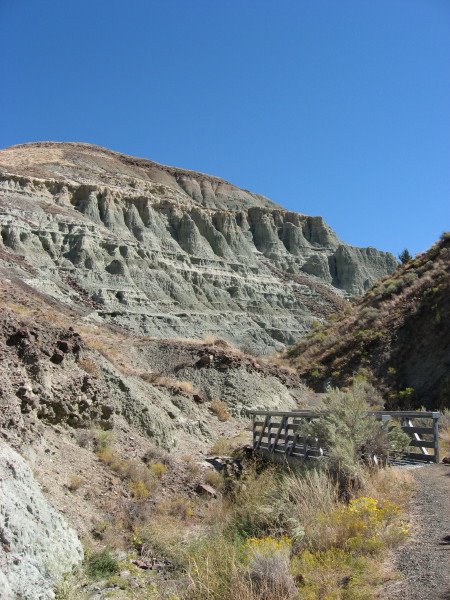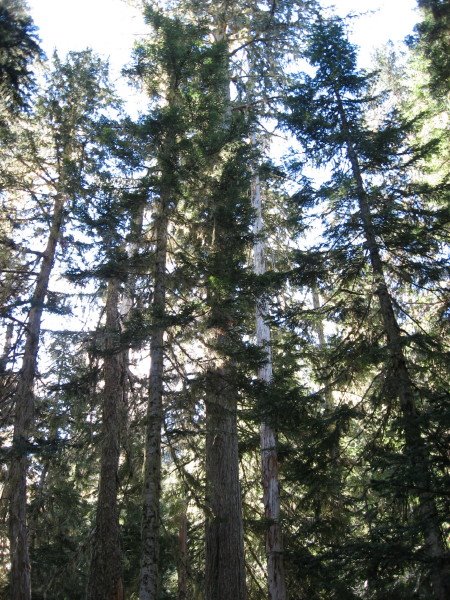![]() Today is National Fossil Day, and half way through Earth Science Week. In honor of the occasion, I present a few notes and photos from a trip I took with my botanist mother to the John Day Fossil Beds in 2006.
Today is National Fossil Day, and half way through Earth Science Week. In honor of the occasion, I present a few notes and photos from a trip I took with my botanist mother to the John Day Fossil Beds in 2006.
The most complete range of Tertiary fossils found anywhere on earth is found in the John Day Fossil Beds. Rocks ranging from 44 million to 7 million years old contain an amazing assemblage of plants and animals. The rocks and fossils bear witness to evolutionary processes, changing climatic and environmental conditions, and vast volcanic environments. While various Tertiary rocks span much of eastern Oregon, a wide array are concentrated within the three units of the John Day Fossil Beds National Monument. The monument consists of three disconnected units, and covers far too much ground to be visited in a single day. Fortunately, the main visitor center is has an incredibly informative display of fossils, complete with painted murals and ambient sounds. My friend Regan Dunn was a paleobotanist with the monument at the time I visited, and it was a thrill to see her name on several of the collection tags.
In the Painted Hills Unit, fossil soils are the main feature that draw the eye. The red bands on the hills (to the right) are fossil woodland soils , while the yellow bands are fossil soils from open woodlands or wooded grasslands. The black streaks represent fossil soils that formed in water-logged environments.
Also at the Painted Hills Unit, the Bridge Creek Flora is exposed. It is a 34 million year old assemblage of fossil plants preserved in volcanic ash claystones. The assemblage is dominated by broad-leaved deciduous plants (alder, beech, etc.) along with roses, grapes, and dawn redwood, and most of the genera are no longer found in the Pacific Northwest. Instead, these forest types are now found in China – where the climate is warmer and wetter than eastern Oregon.
The Sheep Rock Unit of the Monument contains the visitor center, the namesake rock with great stratigraphy exposed, and the Bue Basin trail whick wanders through a fossil-rich badlands environment (to the right). The Blue Basin exposes the Turtle Cove formation, dating from 28-33 million years ago, when the area was covered by woodland and wooded grassland. This formation is fossiliferous and mammals, turtles, snails, and hackberries are just a few of the remains that have been found in these layers. Winter rains and summer thunderstorms erode the sediment layers exposing new fossils on a regular basis. Once exposed to the elements, however, the fossils degrade fairly quickly. Although the area is rich in fossils, they are hard to spot from the trail, and I made the one and only find of the hike. Two small fragments of fossil wood are directly below and below-right of my extra memory card.
After the hike, we drove to the town of Fossil (their gas station is called Fossil Fuel), where you can collect fossils (for a nominal fee) behind the local high school. We spent ~3 hours digging and looking at all sorts of wonderful flora from the Bridge Creek Flora and came away with some nice specimens of metasequoia, alder, and sycamore leaves and wood prints.
On the way back to Corvallis, we stopped in Echo Basin in the Cascades Range to to visit some living trees – a disjunct population of Alaskan cedar (to the right). Disjunct means that these trees are isolated from the main range of their species, and are able to survive only because of very special environmental conditions. These trees towered up to 100 feet over us and got up to 4 feet in diameter. We wandered through the natural cathedral and contemplated climate change on a range of time scales.
35 million years ago, eastern Oregon was warm and wet – today it is a desert with frigid winters. 15,000 years ago glaciers covered the area where we visited the cedars, and they were left in a pocket of cold air drainage as the climate warmed into the Holocene. And what will happen to the cedars as climate warms even further, thanks to CO2 levels that haven’t been experienced in the past 25 million years?
Liked this post? Then how about helping 2nd graders in Indiana get their hands on fossils through our Earth Science Challenge?







Comments (5)
Links (3)-
-
-
Pingback: Quick Links | A Blog Around The Clock
Pingback: Scientia Pro Publica 43: Loving, Living, Learning « Traversing the Razor
Pingback: Sunday Science Photos, June 27–July 1 | Uncovered Earth